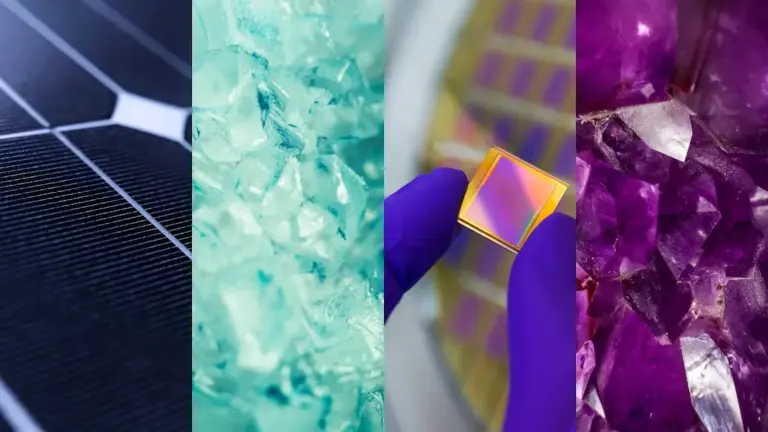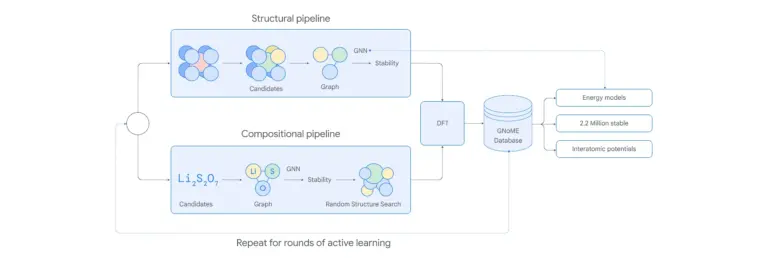The search for new materials has historically driven human progress, from bronze tools that shaped ancient civilizations to modern superconductors powering magnetic levitation trains. Today, artificial intelligence stands ready to accelerate this process beyond anything previously imaginable. Google DeepMind’s revolutionary Graph Networks for Materials Exploration (GNoME) system represents a quantum leap forward, discovering 2.2 million new crystal structures in what would traditionally require 800 years of research.
The Materials Discovery Revolution Begins
Traditional materials research has long resembled an elaborate guessing game. Scientists would modify existing compounds or experiment with new element combinations, often spending months on trial-and-error processes with limited success. This painstaking methodology has yielded approximately 48,000 computationally stable crystals over decades of research.
GNoME shattered these limitations in a single breakthrough. The AI materials science platform identified 380,000 stable materials with potential applications spanning superconductors, advanced batteries, and next-generation electronics. External researchers have already synthesized 736 of these predictions in laboratories worldwide, validating the system’s remarkable accuracy.
The implications extend far beyond raw numbers. Where conventional approaches achieved roughly 50% accuracy in predicting material stability, GNoME reaches 80% precision. This dramatic improvement transforms AI materials discovery from experimental curiosity into practical scientific tool.
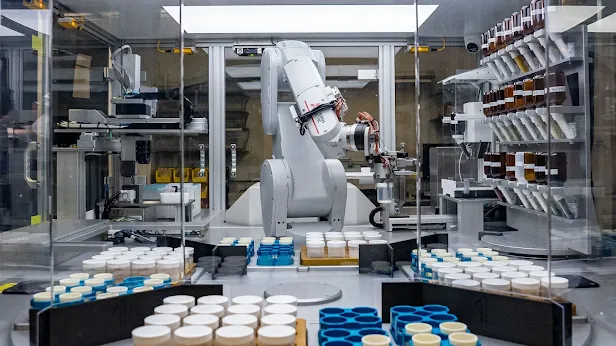
Inside A-Lab, a facility at Berkeley Lab dedicated to developing artificial intelligence that guides robots to create new materials. Photo credit: Marilyn Sargent/Berkeley Lab
How GNoME Revolutionizes Crystal Structure Prediction
GNoME operates through sophisticated graph neural networks that model atomic connections within crystalline structures. Unlike previous systems that relied heavily on existing material databases, this approach generates entirely novel configurations based on fundamental chemical principles.
The system employs dual discovery pipelines working in concert. The structural pipeline creates candidates resembling known crystals but with modified arrangements, while the compositional pipeline explores completely randomized chemical formulas. Both outputs undergo rigorous evaluation using Density Functional Theory calculations, ensuring only viable materials advance through the discovery process.
Active learning techniques dramatically enhanced GNoME’s performance during development. The system would generate novel crystal predictions, test them using established computational methods, then incorporate results back into its training data. This iterative refinement process boosted discovery rates from under 10% to over 80%, representing unprecedented efficiency gains.
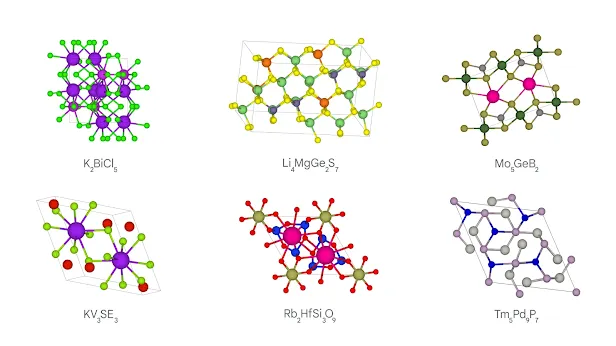
AI materials science: six examples ranging from a first-of-its-kind Alkaline-Earth Diamond-Like optical material (Li4MgGe2S7) to a potential superconductor (Mo5GeB2). Image credit: Google DeepMind
Breakthrough Applications Emerge from AI Materials Science
GNoME’s discoveries include 52,000 new layered compounds similar to graphene, materials that could revolutionize electronics through superconducting properties. Previously, only 1,000 such structures were known to science. The system also identified 528 potential lithium ion conductors—25 times more than previous studies—promising significant improvements in rechargeable battery performance.
These materials don’t exist merely as theoretical constructs. The Li4MgGe2S7 alkaline-earth diamond-like optical material represents the first of its kind, while Mo5GeB2 shows potential as a superconductor. Such discoveries demonstrate how AI materials discovery translates computational predictions into tangible scientific advancement.
Energy storage applications appear particularly promising. As renewable energy adoption accelerates, demand grows for batteries supporting higher energy densities, faster charging, and extended lifespans. GNoME’s predictions could unlock materials enabling these crucial improvements.
Beyond Discovery: Autonomous Synthesis Integration
Lawrence Berkeley National Laboratory researchers partnered with Google DeepMind to demonstrate automated materials synthesis using GNoME predictions. Their robotic laboratory successfully created over 41 new materials through autonomous processes, proving that AI materials science extends beyond identification into practical manufacturing.
This integration represents a fundamental shift toward automated research workflows. The A-Lab facility uses artificial intelligence to guide robots through synthesis procedures, creating feedback loops between prediction and validation. Such systems could soon enable David’s scenario—scientists collaborating with AI platforms that generate millions of molecular structures, predict properties, and autonomously execute synthesis tasks.
Expanding the Materials Universe
Microsoft’s complementary MatterGen and MatterSim tools demonstrate how AI materials discovery continues evolving. MatterGen generates novel inorganic materials based on specific property requirements, while MatterSim validates these predictions through computational analysis. Together, they create thousands of potential materials with desired characteristics in fraction of traditional timeframes.
This generative approach marks a crucial distinction from earlier methods. Rather than modifying existing materials, these systems engineer completely new atomic arrangements tailored to precise specifications. Scientists can now request materials with specific symmetry, mechanical properties, or electronic characteristics, receiving viable candidates within hours instead of years.
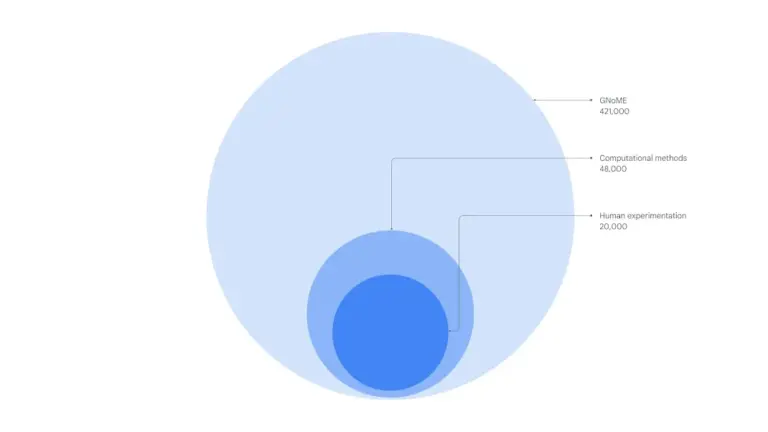
About 20,000 of the crystals experimentally identified in the ICSD database are computationally stable. Image credit: Google DeepMind
The Computational Foundation
GNoME’s architecture builds upon graph neural networks specifically optimized for crystalline structure analysis. Input data takes the form of atomic connection graphs, making these networks particularly suited for materials applications. The system was initially trained using crystal structure data from the Materials Project, then refined through progressive learning cycles.
The convex hull concept proves central to stability assessment. For materials to be considered stable, they must not decompose into similar compositions with lower energy. GNoME’s 2.2 million discoveries all lie below the convex hull of previous findings, with 380,000 materials occupying the “final” convex hull representing the new stability standard.
Global Impact and Future Directions
The broader implications of AI materials science extend across industries facing materials constraints. Aerospace applications could benefit from lightweight, durable materials enhancing aircraft and spacecraft performance. Medical device development might incorporate new materials for improved implants and drug delivery systems. Environmental applications could address pressing challenges through materials enabling better water purification, carbon capture, and waste management.
Startup activity reflects growing commercial interest. Companies like XtalPi achieved $2.5 billion valuations, while Isomorphic Labs secured partnerships with major pharmaceutical companies worth potentially $3 billion. This investment surge indicates that AI materials discovery has moved beyond academic curiosity into practical business applications.
Challenges and Opportunities Ahead
Despite remarkable progress, significant obstacles remain before AI materials science achieves widespread industrial adoption. Data limitations persist as a fundamental constraint—AI models require vast amounts of high-quality experimental data, yet materials databases often suffer from incompleteness and inconsistency. Proprietary formulations remain closely guarded industrial secrets, limiting comprehensive dataset development.
Production environments add complexity beyond laboratory conditions. Materials performance varies significantly across different applications and manufacturing contexts, challenging AI models’ generalization capabilities. High development costs require substantial capital investment and multidisciplinary expertise spanning materials science, chemistry, and algorithm development.
The Path Forward
Success requires bridging gaps between purely data-driven approaches and first-principles methodologies. While deep learning excels at fitting available data, domain knowledge enables effective extrapolation to areas with limited empirical information. Collaborative partnerships between businesses and research institutions will prove crucial for creating comprehensive datasets and continuous algorithm improvement.
The integration of automated experimental platforms with AI predictions represents the next frontier. These systems enable rapid cycles of hypothesis generation, testing, and validation, accelerating progression from theoretical discovery to scalable production. As computing power increases and datasets expand, AI materials discovery will likely become even more precise and comprehensive.
Conclusion: A New Era of Scientific Discovery
GNoME and related AI materials science platforms represent more than technological advancement—they embody a fundamental transformation in how humans discover and develop new materials. By expanding our known universe of stable materials from 48,000 to over 400,000 structures, these systems have effectively multiplied human knowledge by nearly tenfold.
The 736 materials already synthesized from GNoME predictions prove that computational discoveries translate into physical reality. As automated synthesis techniques mature and AI models become more sophisticated, the gap between prediction and application will continue narrowing.
This revolution arrives at a critical moment. Climate challenges demand breakthrough materials for more efficient solar cells, higher-capacity batteries, and effective carbon capture technologies. Global resource competition intensifies the need for innovative solutions. AI materials discovery offers the tools necessary to meet these challenges, potentially unlocking the advanced materials required for a more sustainable future.
The age of AI-accelerated materials science has begun, promising discoveries that will shape technology and society for generations to come.
If you are interested in this topic, we suggest you check our articles:
- AI Agents Blur Business Boundaries
- Manus AI Agent: What is a General AI Agent?
- User Experience vs Agentic Experience: Designing for Delegation and Intent Alignment
- CustomGPT.ai: Genius Tool for Creating Custom AI Agents
Sources: Google DeepMind, Medium, World Economic Forum, aru.ac.uk
Written by Alius Noreika
